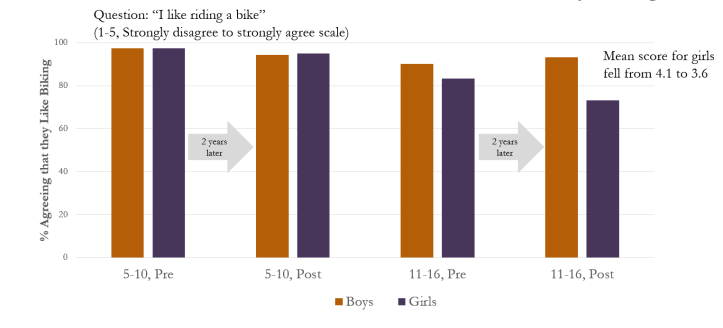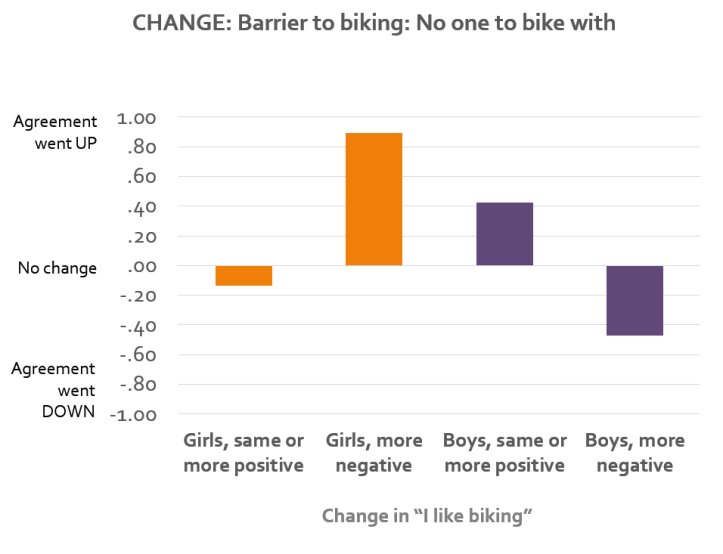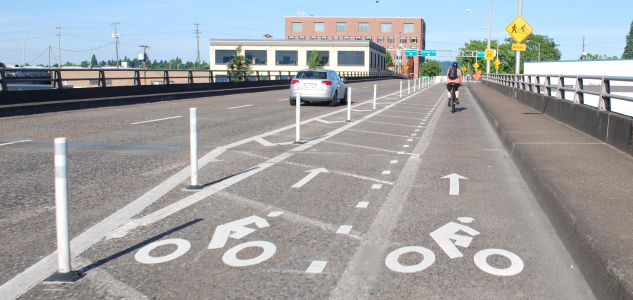Last month, I presented some work I’m doing looking at girls’ attitudes towards bicycling at the Active Living Research Conference in Clearwater, FL. The data are from our longitudinal Family Activity Study, which collected data from over 300 families in Portland, OR. We have surveys from kids and their parents at the start of the study and two years later, so we can see how their attitudes and behavior changed. When looking at some of the survey data from the kids, I noticed that girls’ attitudes towards bicycling (measured as agreement with the statement “I like riding a bike”) declined over time among the 11-16 year-olds (figure below). The same thing didn’t happen among the younger kids, nor among the older boys.

Given that women bike far less than men (at least in the US), and attitudes are a strong predictor of why people, particularly women, do not ride, I wanted to explore this further. (I will note that overall attitudes were very positive, averaging 3.6 on a 1-5 scale for the girls after two years.) I divided the older boys and girls into two groups each — those whose attitudes grew more negative during the two years (19 girls and 19 boys) and those whose attitudes stayed the same or improved (35 girls and 45 boys). For brevity here, I’ll call the former group the “negative girls” or “negative boys.” Why are these attidues important? It appears that the change in girls’ attitudes may be affecting their behavior. The negative girls biked about 70% less after two years, significantly different than the rest of the girls. There was not a decline in bicycling among the negative boys.
To understand what might be driving these changes in attitudes, I looked at changes in other attitudes and perceptions about the environment, as well as objective measures of the environment and demographics. A few factors were correlated with the changes, including perceptions of traffic safety and confidence riding with traffic. For example, for the negative girls, their agreement with the statement “traffic in our neighborhood makes it difficult or unpleasant for me to bike alone in our neighborhood” went up, while it went down for the other girls and for all the boys (figure below). The negative girls’ comfort level riding alone in different street environments also went down, while it went up for the other girls and went up or stayed about the same for all the boys. These findings indicate that programs that help girls feel more confident riding, such as classes and group rides, may be important for getting more girls riding. Infrastructure that reduces interactions with motor vehicles may also help.

The negative girls were also more likely to increasingly think biking takes too long. This parallels other research I’ve done showing time as a reason women do not bike. There also seem to be social aspects to bicycling for girls. The negative girls increasingly said that having no one to bike with was a barrier (figure below). For some reason, the opposite happened among the boys. The negative girls were also much less likely over the two years to say that their friends thought they should bike more.

Rain as a barrier for biking also increased among the negative girls more so than other girls and all the boys. Not liking to wear helmets correlated with negative attitudes among both the girls and boys, though it wasn’t a barrier for many of the kids.
There were many things that were not correlated with the negative changes in attitudes, including attitudes towards driving (wanting to drive) and thinking biking is cool (or not). This may be the influence of living in Portland, where bicycling is generally viewed as normal, and perhaps even “hip.” The changes were also not associated with objective measures of the neighborhood environment, including street connectivity or bike infrastructure. However, the neighborhoods in our study did not vary that much; this might be a factor in other places. And, remember that perceptions of the neighborhood were important.
The presentation from the conference is here. These findings are just part of the analysis I’m working on. Stay tuned for more.

[…] Why do girls’ attitudes toward bicycling decline as they get older? (Jennifer Dill) […]
LikeLike
[…] Dill, a planning professor at Portland State University, is taking a close look at why girls’ attitudes about biking change over time. In a longitudinal study of 300 […]
LikeLike
[…] Dill, a planning professor at Portland State University, is taking a close look at why girls’ attitudes about biking change over time. In a longitudinal study of 300 […]
LikeLike
I see personal safety was asked about, but what about harassment? Is that a factor?
LikeLike
I did not ask about that specifically, but do think that it could be a factor, particularly in some places
\
LikeLike
Bit of a missed opportunity I would say
LikeLike
[…] the course of two years. Dill found that the girls between 11 and 16 who lost interest in biking shared common concerns: They felt less safe riding in traffic (even in areas with designated bike lanes), they were […]
LikeLike